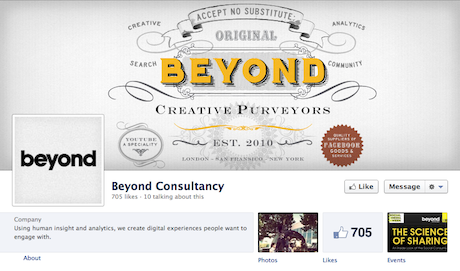Speaker Q&A with Nils Mork-Ulnes, Head of Analytics at Beyond
The Facebook Marketing Conference (Weds 18th Jul) is only a week away and to give you a sneak peek into some of the insight that'll be shared, we've managed to grab a few minutes with some of the speakers.
Up first is Nils Mork-Ulnes, Head of Analytics at Beyond.
 Nils previously ran Next Fifteen’s research brand Context Analytics based in San Francisco, now part of Beyond. With more than 18 years of experience managing research and consulting projects globally for clients such as Cisco, Visa, Sony, and Microsoft, his areas of research specialization include: brand and corporate reputation management, social media marketing, and marketing optimization analysis.
Nils previously ran Next Fifteen’s research brand Context Analytics based in San Francisco, now part of Beyond. With more than 18 years of experience managing research and consulting projects globally for clients such as Cisco, Visa, Sony, and Microsoft, his areas of research specialization include: brand and corporate reputation management, social media marketing, and marketing optimization analysis.
Is sharing different between say, Twitter and Facebook or are the fundamentals the same?
Yes, the sharing platforms do differ in a number of ways. Fundamentally, people are usually connected to others on Facebook for different reasons than why they are connected on Twitter, LinkedIn or Pinterest.
At a high level one can make the distinction between "social graphs" and "interest graphs" - i.e., whether people are connected because they know each other or because they share an interest - and sharing behaviour does differ between the two. For the former, sharing is typically driven off of social dynamics - say, to entertain or impress people you know (which is why funny cat pictures and holiday snaps tend to be the norm). For the latter, it is more focused on sharing of content that is highly relevant to a community of interest.
But many of the platforms are a combination of social and interest graphs - people are often connected on Twitter and Pinterest both because they know each other and because they share interests. Also, from our research we find that people cite different motivations for sharing content - many share because they want to help others ("altruists"), while others share primarily to provoke a reaction ("provocateurs") - depending on the motivation, we find that people will use different channels. Altruists rely more heavily on Facebook and email, while Provocateurs are more likely to use other channels such as blogging, Twitter, or YouTube.
Lastly, even within platforms there are differences - for example, Facebook's own analytics teams has found differences between "weak ties" and "strong ties" which help explain how information is disseminated across the network.
What’s the main implication of social sharing for brands?
Social sharing is very much a modern incarnation of "word of mouth," which brands have always known to be a critical part of marketing and the creation of brand value - but a very hard thing to measure and manage. Nonetheless, there is a large body of research documenting the much higher perceived credibility of recommendations from an individual than of that of an ad. Further, a highly satisfied customer is likely to recommend a product to a large number of other people.
The exciting thing about social sharing is that not only does that recommendation effect get amplified online by potentially reaching a much larger audience, but it also becomes much easier to measure and manage because it is happening online. In fact, research we have done shows that people who are active social sharers are three times more likely to recommend a brand. Further, we see that the consumers' decision journeys are increasingly taking place online and that people considering a purchase are very much influenced by existing customers sharing their experiences. Therefore, brands who are only spending money on awareness-creation through ads risk losing out when the actual purchasing decisions are made during interplay between the pre-purchase consideration stage and the stage of sharing experiences post-purchase in a customer journey.
Do people share brand content or is it just funny pictures of cats?
People absolutely do share brand content - our research shows that 36% of people liked or shared a brand page on Facebook in the last 30 days, and their motivations vary. For some a brand represents who they are, or at least who they want to be seen to be. People often have very emotional connections to brands - just ask any Mac person if they'd consider buying a PC. And brands like Coke speak of "brand love" as a critical KPI - precisely because that emotional bond is critical to transcending the fact that it is really just a fizzy drink. People are often sharing content because they feel that connection.
But probably the biggest motivation we see is to "get a deal" or a discount - more than would 60% like or share branded content for that reason. So if everything else fails, "bribes" are a proven strategy...
Is the maturity of the social networks changing how much we share?
Yes, our research shows that the longer people are on Facebook, the more frequently they log on to consume content and the less frequently they share content. Also, sharing is increasingly taking new forms - such as frictionless sharing increasing the portion of sharing that is "passive" - i.e., done without the user actively initiating a share.
Are privacy concerns having any impact on sharing?
Yes, we see in our research that 61% of people are annoyed by frictionless sharing, and that privacy is one of the reasons cited. In general, privacy settings do encourage people to share more, but privacy is a clear driver of people's overall concern with social media and sharing of content through it.



